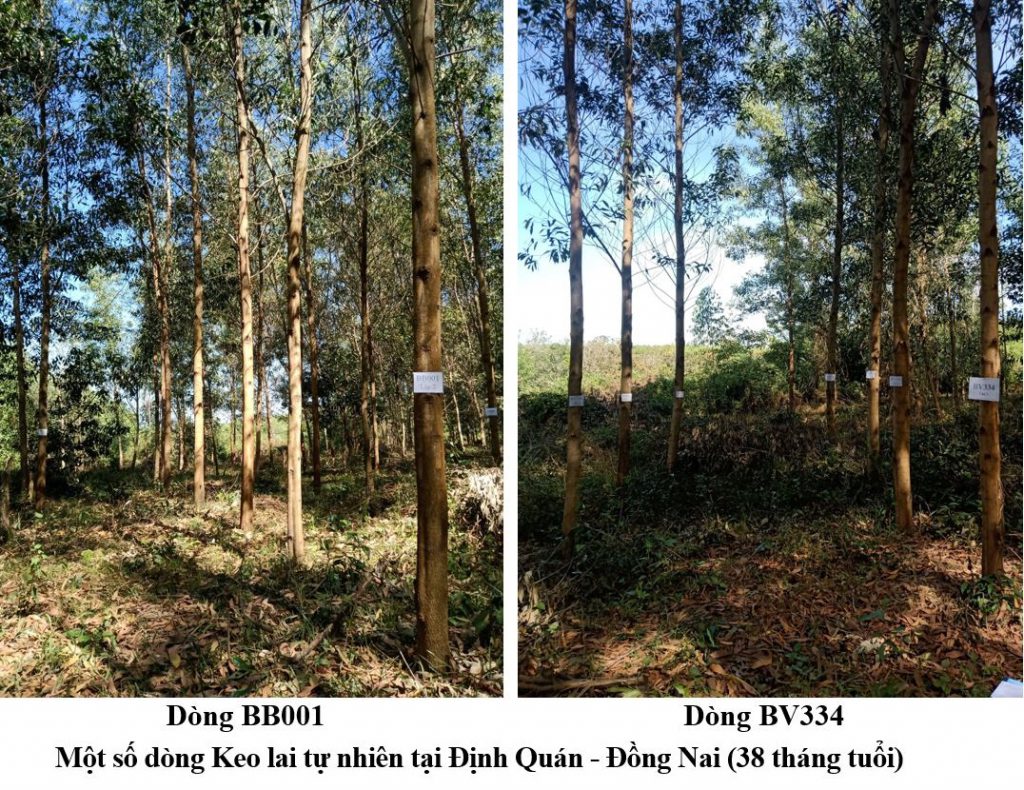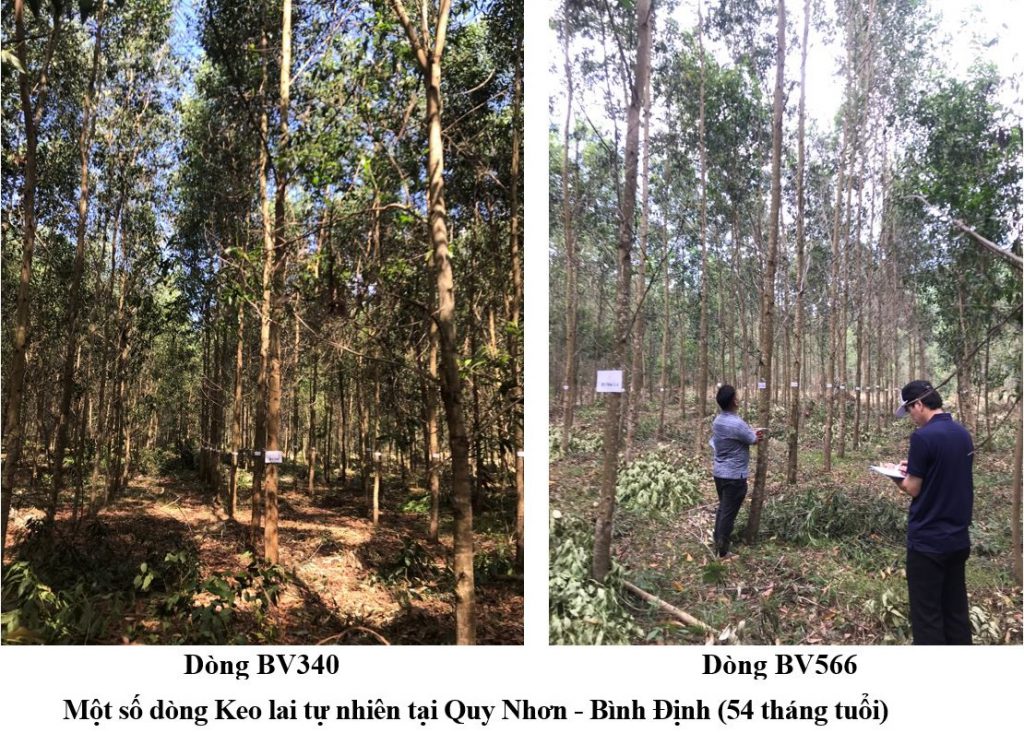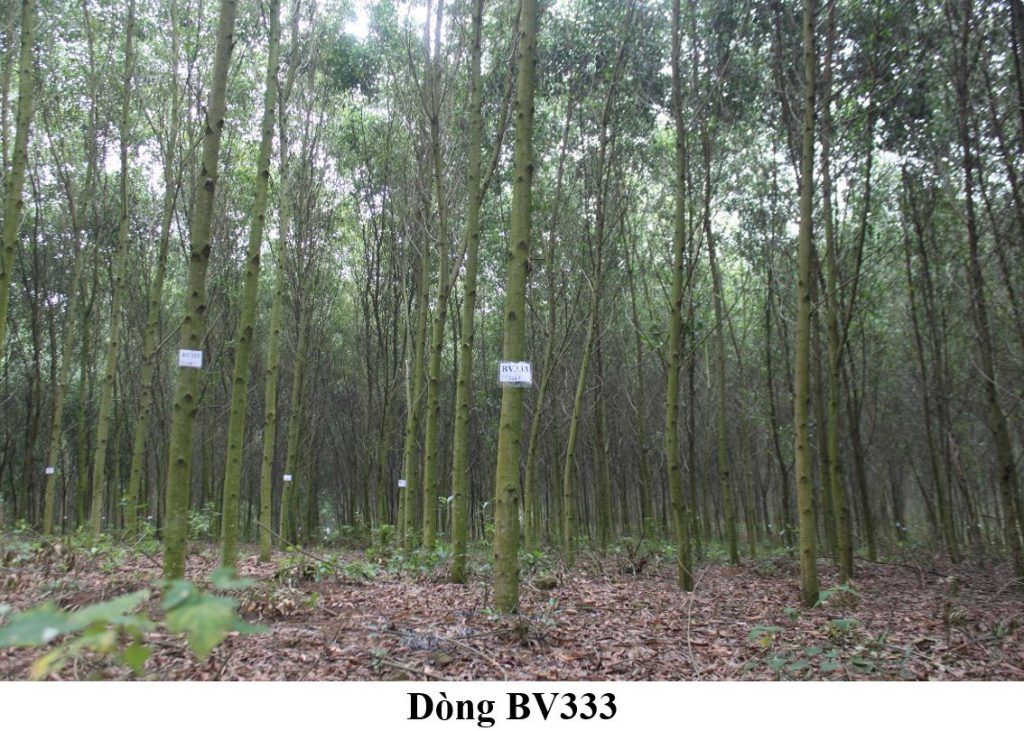GENERAL INFORMATION:
Funding institution: Ministry of Agriculture & Rural Development of Vietnam
Project lead organization: Vietnam Academy of Forestry Sciences
Project implementation organization: Institute of Forest Tree Improvement and Biotechnology
Project leader: Dr. Nguyen Duc Kien
Implementation time: 2017-2022
OBJECTIVES AND RESEARCH THEMES:
General objectives:
- To select, breed and develop natural and artificial acacia hybrid clones, Acacia auriculiformis clones for high productivity, disease resistance and high quality wood for timber plantations.
- To develop the propagation techniques for newly selected acacia hybrid and Acacia auriculiformis clones.
Specific objectives:
- To select at least 02 natural Acacia hybrid clones/region with minimum productivity of 25 m3/ha/year for the Northeast, North Central and South Central region; 30 m3/ha/year for Southeast region having good quality wood and meeting the requirements of sawn timber for furniture production, recognized as technologically advanced varieties.
- To select at least 02 Acacia auriculiformis clones/region with minimum productivity of 20 m3/ha/year for South Central region; 25 m3/ha/year for Southeast region, having good quality wood and meeting the requirements of sawn timber for furniture production, recognized as technologically advanced clones.
- To create 5 to 10 promising reciprocal interspecific hybrid combinations between Acacia mangium and Acacia auriculiformis and create 5 to 10 promising intraspecific hybrid combinations for Acacia auriculiformis.
- To establish 01 ha of clonal seed orchard of Acacia auriculiformis of newly selected clones.
- To develop 02 technical guidelines for vegetative propagation of newly selected clones of natural Acacia hybrid and Acacia auriculiformis using tissue culture technique.
- To establish 12 ha of natural Acacia hybrid trials and 06 ha of Acacia auriculiformis trials (5 ha for clonal trials: 2.5 ha in South Central region; 2.5 ha in Southeast region; 1 ha for intraspecific hybrid combination testing trial in Southeast region).
Research themes:
Theme 1: Research on selecting and testing natural Acacia hybrid clones for high productivity and wood quality for large timber plantations.
- Selecting of better performing clones of natural acacia hybrid in clonal screening trials established from 2011 to 2015 and testing to recognize promising clones.
- Selecting natural hybrid trees from the seedlots of plus tree families of Acacia mangium and Acacia auriculiformis seed orchards and conducting early selection.
Theme 2: Research on selecting and testing A. auriculiformis clones for high productivity and good quality for large timber plantations
- Selecting plus trees of Acacia auriculiformis in seed orchards and testing for elite clone selection
- Establishing a clonal seed orchard for newly selected clones of Acacia auriculiformis.
Theme 3: Research on artificial hybrid that integrating growth and wood properties and establishing hybrid testing trials.
- Research on intraspecific crossing for Acacia auriculiformis.
- Research on interspecific crossing betweenAcacia mangium and Acacia auriculiformis.
Theme 4: Research on propagation by tissue culture technique for newly selected clones of natural Acacia hybrid and Acacia auriculiformis
- Research on propagation by tissue culture technique for natural Acacia hybrid and Acacia auriculiformis clones
- Developing 02 technical guidelines for the vegetative propagation of newly selected clones of natural Acacia hybrid and Acacia auriculiformis using tissue culture technique.
Key results:
The project has completed the research objectives and meets the volume, quality and progress ordered. The specific conclusions for each research theme are as follows:
Theme 1:
- Evaluation results from clonal trials and hybrid combinations testing trials showed significant differences in growth and stem quality between natural Acacia hybrid clones (Fpr < 0.001).
- There were significant differences in the wood basic density, the physical and mechanical properties of wood as well as the level of infection and severity of wilt caused by Ceratocystis between clones in the trial at Dinh Quan, Dong Nai.
- 10 clones of natural Acacia hybrid were approved by the Ministry of Agriculture and Rural Development, as followings:
- Clones BV97 and BV566 can reach from 25.1 to 25.5 m3/ha/year in Quy Nhon, Binh Dinh (South Central region) and areas with similar ecological conditions.
- Clones BV110 and BV133 can reach from 25.2 to 25.3 m3/ha/year in Cam Lo, Quang Tri (North Central region) and areas with similar ecological conditions.
- Clone BV333 can reach 28.1 m3/ha/year in Ba Vi, Hanoi (Northeast region) and some areas with similar ecological conditions.
- Clone BV102 can reach 25.7 m3/ha/year in Ba Vi, Hanoi (Northeast region), and reach 25.2 m3/ha/year in Cam Lo, Quang Tri (North Central region) and areas with similar ecological conditions.
- Clone BV340 can reach 26.4 m3/ha/year in Cam Lo, Quang Tri (North Central region), reach 30.7 m3/ha/year in Quy Nhon, Binh Dinh (South Central region) and areas with similar ecological conditions.
- Clones BB001, BV334 and BV518 can reach 34.1 to 36.2 m3/ha/year in Dinh Quan, Dong Nai (Southeast region) and areas with similar ecological conditions.
- The broad-sense heritability of growth traits ranged from low to high and increase with age. Genotype–environment interaction varied between site pairs and inversely proportional with distance between sites.
- The study selected 2.000 natural hybrid trees from 100 seedlots of plus trees of Acacia mangium and Acacia auriculiformis. This study also selected 100 plus trees (50 plus trees/trial) according to TCVN 8755:2017. At Ba Vi, the superiority in diameter and height of plus trees compared to the trial average was 35.7 – 97.9% and 20.1 – 50.1%, respectively. At Dinh Quan, Dong Nai, this index was 27.3 – 71.8% and 27.5 – 56.9%, respectively.
Theme 2:
- There were significant differences in growth and stem quality between clones in the three trials at Quy Nhon, Binh Dinh; Dinh Quan, Dong Nai, and Bau Bang, Binh Duong (Fpr<0.001).
- At Quy Nhon, Binh Dinh: 2 clones LT156 and LT70 were identified as superior growth with MAI ranged from 20,4 m3/ha/year to 20,9 m3/ha/year, exceeding from 11,4 % to 14,2 % compared with previously approved clone AA9 that was used as control. These clones were recognized as new cultivars for Quy Nhon, Binh Dinh and areas of similar ecological conditions.
- At Dinh Quan, Dong Nai: clones LT43, LT94, LT42 and LT5 were identified as having superior growth with the production from 18.1 to 19.5 m3/ha/year, exceeding from 8 to 16% compared with the control (clone Clt98).
- At Bau Bang, Binh Duong: clones LT70, LT74, LT35, and LT63 were identified as having superior growth with the production from 25,4 to 27,1 m3/ha/year, similar to the controls (clones Clt26 and AA9). Clones LT35, LT70, and LT74 were recognized for Bau Bang, Binh Duong (Southeast region), and some areas with similar ecological conditions.
- There were significant differences in the wood basic density, the physical and mechanical properties of wood between the 20 best clones in the trial at Bau Bang, Binh Duong at the 36-month age stage. However, there was no clear difference in these characters between the 10 best clones in the trial at Quy Nhon, Binh Dinh at the 42-month age stage.
- The heritability of growth traits ranged from moderate to high (H2 = 0.15 – 0.40) and tended to increase with age and was higher than those of the stem quality (H2 = 0.03 – 0.20)
- There were significant differences in growth and stem quality between Acacia Auriculiformis clones in the clonal seed orchard at Quy Nhon, Binh Dinh at the 42-month age stage (Fpr <0.001).
Theme 3:
- The study created 30 intraspecific hybrid combinations for Acacia auriculiformis and built 01 ha of hybrid combination testing trials at Bau Bang, Binh Duong. Evaluation results at 3 years old, we identified 10 hybrid combinations having stem volume of 11.4 to 50.4% higher than the average figure of the seedlings from recognized seed orchards that used as control.
- The study also created 50 interspecific hybrid combinations between Acacia mangium and Acacia auriculiformis, and built 01 ha of interspecific hybrid combination testing trials at Dinh Quan, Dong Nai and Ba Vi, Ha Noi (0.5ha/ region). Initial evaluation results at 2 sites showed that there was a significant difference between hybrid combinations. At Ba Vi, Ha Noi, the study identified 10 hybrid combinations having stem volume of 13.5 to 45.6% higher than that of the control (Acacia mangium trees from seed orchards). At Dinh Quan, Dong Nai, we identified 9 hybrid combinations having stem volume of 11.5 to 44.7% higher than that of the control.
Theme 4:
- The study identified the suitable medium for propagation by tissue culture technique for newly selected Acacia hybrid clones, as followings:
- Suitable medium for shoot multiplication: MS* + BAP 1.5 mg/l + NAA 0.25 mg/l.
- Suitable medium for rooting: 1/2MS* + IBA 1.5 mg/l, the time for the rooting period was 17-20 days.
- The study also identified the suitable medium for propagation by tissue culture technique for newly selected Acacia auriculiformis clones, as followings:
- Suitable medium for shoot multiplication: MS* + BAP 1.0 mg/l + NAA 0.5 mg/l
- Suitable medium for rooting: 1/2MS* + IBA 1.5mg/l
- The study has developed the technical guidelines for the micropropagation technique of 8 Acacia hybrid clones and 3 Acacia auriculiformis clones recognized.
Latest news
- Project: "Research on improving the economic efficiency of plantation timber value chains, meeting legal timber requirements and sustainable forest management"
- Project: Commercial-scale yield trial and completion of planting techniques for newly recognized acacia hybrid cultivars (BV586, BV376, BB055, BV584, BV523, BV434, BV350)
- Project: Study on technology of producing hollow veneer-based composite used in construction and interior wooden furniture
- VFCS is published on the website of the Forestry Department, Ministry of Agriculture, Forestry and Fisheries of Japan
- Memorandum of Understanding signing ceremony on handing over new wood material samples from the Finnish Embassy to the VAFS for displaying
Oldest news
- Vietnam Journal of Forest Science Number 6-2022
- Project: Study on integrated pest management of major leaf insect pests and stem borer beetles in Acacia hybrid, A. mangium and A. auriculiformis in Vietnam
- Project: Research and develop an integrated management program for control of cinnamon pests in some main cinnamon growing areas (Northern mountainous region and Quang Nam province)
- Project: Pilot plantation and completion of planting techniques of technologically advanced germplasm of Acacia auriculiformis (AA42, AA53, AA56, AA92, AA95) for sawlog in the southeast and south central.
- Project: “Perfecting the technology of producing high-quality multilaminar block from some plantation woods for furniture and art products”.









